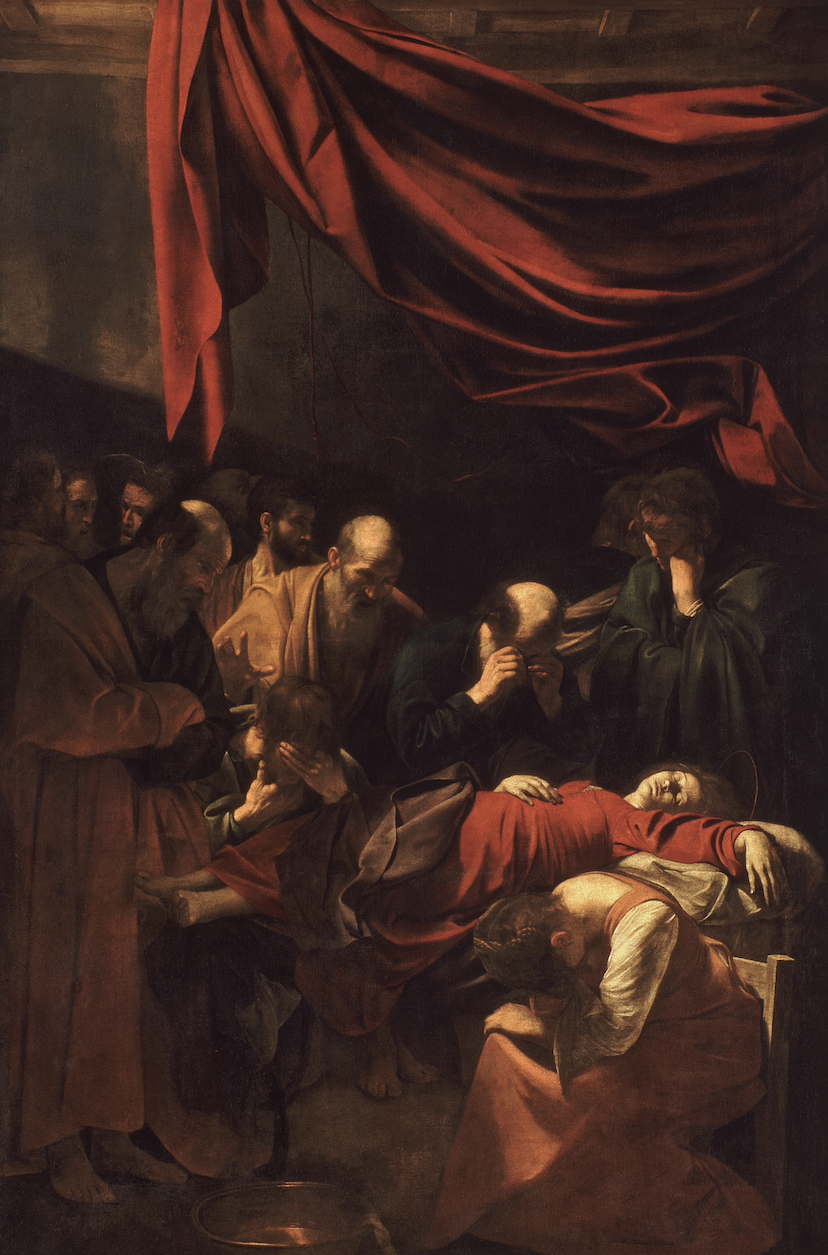
“Death of the Virgin”, 1601- 1605/06, Caravaggio, Louvre, Paris.
The Virgin is surrounded by the Apostles and Mary Magdalene. Caravaggio is following the tradition that the apostles who had been dispersed to preach the gospel were miraculously transported to her deathbed. There is a woman on lower right who weeps; her face hidden in grief. There is a copper bowl at her feet as if to wash the corpse. She resembles Mary Magdalene as shown in “The Entombment” of a few years before. Similarly, the figure standing on the left is probably St Peter. Next to him, the kneeling apostle might be St Andrew. Just behind him, the figure whose right hand is raised might be St Paul. The man with his fists on his eyes might be St Matthew. The younger man standing on the right might be St John. The more you look at these figures the more you sense their profound grief. From his Roman patrons Caravaggio had easy access to any number of deathbed scenes in their collections of antique statuary. St Peter’s hands are enfolded in his cloak. This was the gesture of an orator as he prepares to speak, but it was also one of reverence. The Virgin looks stiff with her outstretched feet but her face is at peace and although its pallor is that of death she just might be asleep. Her arms are arranged like those of someone asleep. As yet nobody has laid her hands upon her chest. The realism is surely unprecedented. It is as if she had just died. By convention, the bare feet of the apostles is a sign of their sanctity. The weight of their garments seems to be an expression their overwhelming grief. Anyone who has been at a deathbed would not pass this painting by. It is that moment when the blood has drained from the face. Caravaggio captures that strange silent moment when her breath can no longer be heard. This is surely why St Paul has raised his hand. This painting was rejected by the Carmelite Fathers, when it was completed for their church in 1604/05. Their reason was the lack of decorum in the depiction of the Virgin. It was suggested that the actual model was a particular prostitute associated with Caravaggio. However, as with much of Caravaggio’s life, what actually was the case is unknown. The painting was put up for sale, and through the agency of no less a figure than Rubens, it entered the Gonzaga collection in Mantua. Moreover, before it left Rome, it was put on display for a week. Caravaggio wasn’t given the opportunity to paint a second version. Shortly after this rejection he would flee Rome, having killed a man. Caravaggio did not show their desired heavenly scene with golden clouds opening up to welcome the Virgin into heaven. There is just a timber roof enclosing human grief at the departure of a much loved woman. However, there is a red mantle suspended above them. It is a familiar prop from his works. Sometimes it served as a cloak but here it is arranged like a make-shift canopy over the make-shift deathbed of the Virgin. The more you look at this work the more you begin to see the subtly of how Caravaggio suggests the transitus of the Virgin and indeed her Queenship. The eye is swept upwards from the red of her dress into the folds of the red canopy. The heavily shrouded figures below see only the dead body but we have a larger view. The viewer sees below familiar grief at the loss of a loved one. But as the eyes are raised upwards, this red banner calls the viewer to the hope that Mary’s Assumption into heaven represents for us all.
The Catholic Chaplaincy serves the students and staff of the University of Edinburgh, Edinburgh Napier University and Queen Margaret University.
The Catholic Chaplaincy is also a parish of the Archdiocese of St Andrews and Edinburgh (the Parish of St Albert the Great) and all Catholic students and staff are automatically members of this parish.